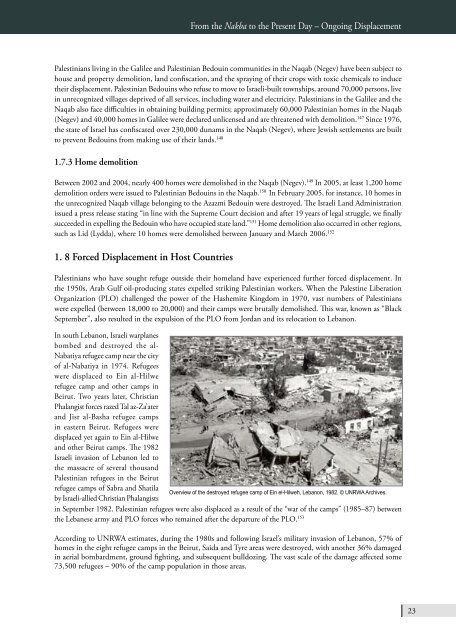BADIL Resource Center for Palestinian Residency and Refugee
BADIL Resource Center for Palestinian Residency and Refugee
BADIL Resource Center for Palestinian Residency and Refugee
Create successful ePaper yourself
Turn your PDF publications into a flip-book with our unique Google optimized e-Paper software.
From the Nakba to the Present Day – Ongoing Displacement<br />
<strong>Palestinian</strong>s living in the Galilee <strong>and</strong> <strong>Palestinian</strong> Bedouin communities in the Naqab (Negev) have been subject to<br />
house <strong>and</strong> property demolition, l<strong>and</strong> confiscation, <strong>and</strong> the spraying of their crops with toxic chemicals to induce<br />
their displacement. <strong>Palestinian</strong> Bedouins who refuse to move to Israeli-built townships, around 70,000 persons, live<br />
in unrecognized villages deprived of all services, including water <strong>and</strong> electricity. <strong>Palestinian</strong>s in the Galilee <strong>and</strong> the<br />
Naqab also face difficulties in obtaining building permits; approximately 60,000 <strong>Palestinian</strong> homes in the Naqab<br />
(Negev) <strong>and</strong> 40,000 homes in Galilee were declared unlicensed <strong>and</strong> are threatened with demolition. 147 Since 1976,<br />
the state of Israel has confiscated over 230,000 dunams in the Naqab (Negev), where Jewish settlements are built<br />
to prevent Bedouins from making use of their l<strong>and</strong>s. 148<br />
1.7.3 Home demolition<br />
Between 2002 <strong>and</strong> 2004, nearly 400 homes were demolished in the Naqab (Negev). 149 In 2005, at least 1,200 home<br />
demolition orders were issued to <strong>Palestinian</strong> Bedouins in the Naqab. 150 In February 2005, <strong>for</strong> instance, 10 homes in<br />
the unrecognized Naqab village belonging to the Azazmi Bedouin were destroyed. The Israeli L<strong>and</strong> Administration<br />
issued a press release stating “in line with the Supreme Court decision <strong>and</strong> after 19 years of legal struggle, we finally<br />
succeeded in expelling the Bedouin who have occupied state l<strong>and</strong>.” 151 Home demolition also occurred in other regions,<br />
such as Lid (Lydda), where 10 homes were demolished between January <strong>and</strong> March 2006. 152<br />
1. 8 Forced Displacement in Host Countries<br />
<strong>Palestinian</strong>s who have sought refuge outside their homel<strong>and</strong> have experienced further <strong>for</strong>ced displacement. In<br />
the 1950s, Arab Gulf oil-producing states expelled striking <strong>Palestinian</strong> workers. When the Palestine Liberation<br />
Organization (PLO) challenged the power of the Hashemite Kingdom in 1970, vast numbers of <strong>Palestinian</strong>s<br />
were expelled (between 18,000 to 20,000) <strong>and</strong> their camps were brutally demolished. This war, known as “Black<br />
September”, also resulted in the expulsion of the PLO from Jordan <strong>and</strong> its relocation to Lebanon.<br />
In south Lebanon, Israeli warplanes<br />
bombed <strong>and</strong> destroyed the al-<br />
Nabatiya refugee camp near the city<br />
of al-Nabatiya in 1974. <strong>Refugee</strong>s<br />
were displaced to Ein al-Hilwe<br />
refugee camp <strong>and</strong> other camps in<br />
Beirut. Two years later, Christian<br />
Phalangist <strong>for</strong>ces razed Tal az-Za’ater<br />
<strong>and</strong> Jisr al-Basha refugee camps<br />
in eastern Beirut. <strong>Refugee</strong>s were<br />
displaced yet again to Ein al-Hilwe<br />
<strong>and</strong> other Beirut camps. The 1982<br />
Israeli invasion of Lebanon led to<br />
the massacre of several thous<strong>and</strong><br />
<strong>Palestinian</strong> refugees in the Beirut<br />
refugee camps of Sabra <strong>and</strong> Shatila<br />
by Israeli-allied Christian Phalangists<br />
in September 1982. <strong>Palestinian</strong> refugees were also displaced as a result of the “war of the camps” (1985–87) between<br />
the Lebanese army <strong>and</strong> PLO <strong>for</strong>ces who remained after the departure of the PLO. 153<br />
Overview of the destroyed refugee camp of Ein el-Hilweh, Lebanon, 1982. © UNRWA Archives.<br />
According to UNRWA estimates, during the 1980s <strong>and</strong> following Israel’s military invasion of Lebanon, 57% of<br />
homes in the eight refugee camps in the Beirut, Saida <strong>and</strong> Tyre areas were destroyed, with another 36% damaged<br />
in aerial bombardment, ground fighting, <strong>and</strong> subsequent bulldozing. The vast scale of the damage affected some<br />
73,500 refugees – 90% of the camp population in those areas.<br />
23

















